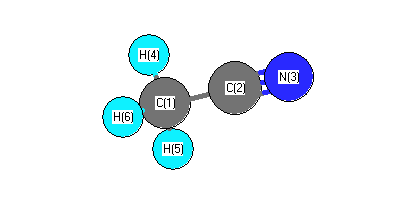Vibrational Frequencies calculated at HF/daug-cc-pVTZ
| Mode Number |
Symmetry |
Frequency
(cm-1) |
Scaled Frequency
(cm-1) |
IR Intensities
(km mol-1) |
Raman Act
(Å4/u) |
Dep P |
Dep U |
|---|
| 1 |
A1 |
3196 |
2891 |
4.65 |
175.21 |
0.00 |
0.00 |
| 2 |
A1 |
2590 |
2343 |
17.91 |
71.72 |
0.11 |
0.20 |
| 3 |
A1 |
1534 |
1387 |
0.10 |
2.52 |
0.44 |
0.61 |
| 4 |
A1 |
960 |
868 |
6.22 |
6.26 |
0.07 |
0.13 |
| 5 |
E |
3271 |
2959 |
3.03 |
52.18 |
0.75 |
0.86 |
| 5 |
E |
3271 |
2959 |
3.03 |
52.18 |
0.75 |
0.86 |
| 6 |
E |
1594 |
1442 |
9.95 |
4.59 |
0.75 |
0.86 |
| 6 |
E |
1594 |
1442 |
9.95 |
4.59 |
0.75 |
0.86 |
| 7 |
E |
1160 |
1049 |
1.18 |
0.10 |
0.75 |
0.86 |
| 7 |
E |
1160 |
1049 |
1.18 |
0.10 |
0.75 |
0.86 |
| 8 |
E |
425 |
385 |
1.83 |
1.90 |
0.75 |
0.86 |
| 8 |
E |
425 |
385 |
1.83 |
1.90 |
0.75 |
0.86 |
Unscaled Zero Point Vibrational Energy (zpe) 10589.4 cm
-1
Scaled (by 0.9046) Zero Point Vibrational Energy (zpe) 9579.2 cm
-1
See section
III.C.1 List or set vibrational scaling factors
to change the scale factors used here.
See section
III.C.2
Calculate a vibrational scaling factor for a given set of molecules
to determine the least squares best scaling factor.
Charges, Dipole, Quadrupole and Polarizability
Charges from optimized geometry at HF/daug-cc-pVTZ
Charges (e)
| Number |
Element |
Mulliken |
CHELPG |
AIM |
ESP |
| 1 |
C |
-0.490 |
|
|
|
| 2 |
C |
-0.453 |
|
|
|
| 3 |
N |
-0.769 |
|
|
|
| 4 |
H |
0.571 |
|
|
|
| 5 |
H |
0.571 |
|
|
|
| 6 |
H |
0.571 |
|
|
|
Electric dipole moments
Electric dipole components in Debye
(What's a Debye? See section
VII.A.3)
| |
x |
y |
z |
Total |
| |
0.000 |
0.000 |
-4.202 |
4.202 |
| CHELPG |
|
|
|
|
| AIM |
|
|
|
|
| ESP |
|
|
|
|
Electric Quadrupole moment
Quadrupole components in D Å
| Primitive |
|---|
| | x | y | z |
|---|
| x |
-17.691 |
0.000 |
0.000 |
| y |
0.000 |
-17.691 |
0.000 |
| z |
0.000 |
0.000 |
-21.064 |
|
| Traceless |
|---|
| | x | y | z |
|---|
| x |
1.687 |
0.000 |
0.000 |
| y |
0.000 |
1.687 |
0.000 |
| z |
0.000 |
0.000 |
-3.374 |
|
| Polar |
|---|
| 3z2-r2 | -6.747 |
|---|
| x2-y2 | 0.000 |
|---|
| xy | 0.000 |
|---|
| xz | 0.000 |
|---|
| yz | 0.000 |
|---|
|
Polarizabilities
Components of the polarizability tensor.
Units are
Å
3 (Angstrom cubed)
Change units.
| |
x |
y |
z |
| x |
3.420 |
0.000 |
0.000 |
| y |
0.000 |
3.420 |
0.000 |
| z |
0.000 |
0.000 |
5.435 |
<r2> (average value of r
2) Å
2
| <r2> |
44.773 |
| (<r2>)1/2 |
6.691 |
